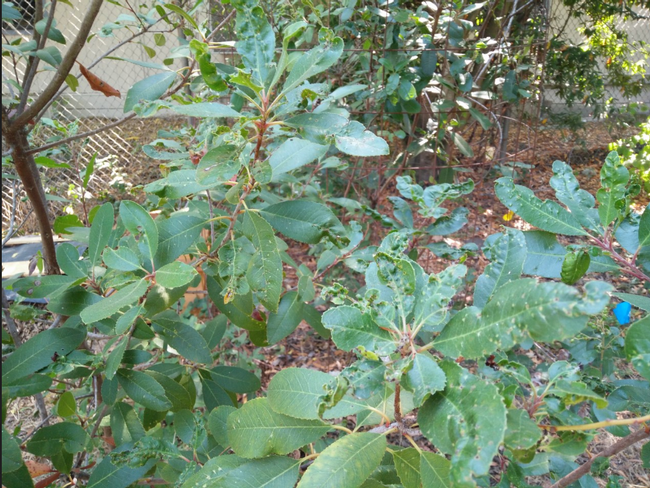A Scab Among Toyons?
Advice from the Help Desk of the
UC Master Gardeners Program of Contra Costa

Scab spots showing on leaves
UCMGCC Help Desk Response: Thank you for sending in the photo of your Toyon. It was very helpful.
Based on the picture, it looks like your Toyon has a mild form of scab. Scab is caused by various types of fungus. Scab appears first as pale or yellow dots on leaves. Affected leaves can twist or pucker. At more advanced stages, which you do not seem to have, you would see dark, olive-colored spots on the leaves. You could also find soft, velvety spots on the undersides of the leaves.

Scab is spread through the air, and more importantly by splashing water. Hot dry weather usually slows the development of scab. The disease is most active during spring rains.
To limit the spread of the disease, remove and dispose in your garbage waste bin of any fallen leaves from the plant. Avoid any overhead watering. You may also want to prune the plant to open up the canopy to allow more air on the leaves.
For more information on scab, see http://ipm.ucanr.edu/PMG/GARDEN/PLANTS/DISEASES/scab.html
For information on pruning, see http://extension.oregonstate.edu/linn/sites/default/files/pruning_pub_handout2012.pdf
Note that there are two basic types of pruning cuts: thinning (which remove entire branches) and heading (which shorten branches). You want to focus on thinning cuts which reduce plant density. See page 2 of the document for the complete descriptions of the differences.
Please let us know if you have further questions.
Good luck with your Toyon.
Help Desk of the UC Master Gardener Program of Contra Costa (ECS)
Note: The UC Master Gardeners Program of Contra Costa's Help Desk is available year-round to answer your gardening questions. Except for a few holidays, we're open every week, Monday through Thursday for walk-ins from 9:00 am to Noon at 75 Santa Barbara Road, 2d Floor, Pleasant Hill, CA 94523. We can also be reached via telephone: (925) 646-6586, email: ccmg@ucanr.edu, or on the web at http://ccmg.ucanr.edu/Ask_Us/ MGCC Blogs can be found at http://ccmg.ucanr.edu/HortCoCo/ You can also subscribe to the Blog (//ucanr.edu/blogs/CCMGBlog/).